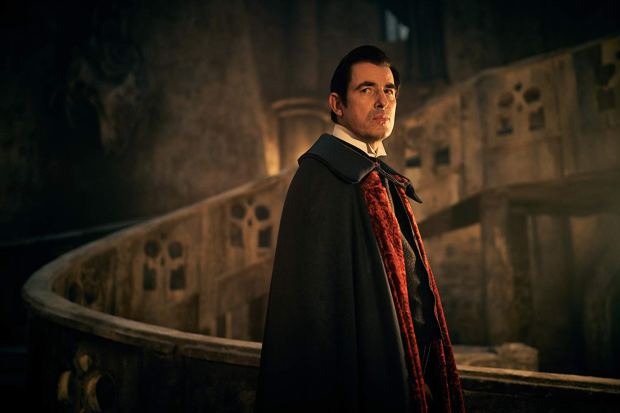
Photo Courtesy of the BBC
How do you make Bram Stoker’s 19th Century Dracula relevant for the 21st Century? How do you tell a vampire story post-Twilight and make the classic monster threatening? The three-part BBC/Netflix adaptation tries to do both with mixed results. Its first episode is reminiscent of early Dracula Hammer films, while drawing fairly heavily from the source material. The second two episodes take bold risks with Stoker’s novel, while trying to maintain the general story-line and characterization. At certain points, the series succeeds in making the vampire relevant in 2020, while at other times, namely in the third episode, there are too many poorly executed leaps.
In terms of the building slow dread and genuine scares, the first episode is the most effective, and it generally follows the beginning of the novel when lawyer Jonathan Harker (John Heffernan) treks to the Count’s Gothic estate to complete a real estate transaction, only to fall prey to the monster, while his fiance Mina (Morfydd Clark) frets over his whereabouts. The challenge of adapting Stoker’s novel is the epistolary form. To handle this, show creators Mark Gatiss and Steven Mofatt still give Harker’s account of his time under the Count’s spell, but they do so by having nuns/vampire hunters (yes, you read that correctly) interview him. Oddly enough, it works. We’re introduced to a pale, badly scarred Harker, and in one of the most effective scares, a fly crawls along and under his eyeball. The presence and stench of death is a reoccurring motif in the novel, and the first episode uses the constant image of flies to reinforce this. It is unnerving and haunting, underscoring the power that the monster still has over Harker. His wounds are both physical and mental.

(Photo Courtesy of the BBC)
Claes Bang is generally a captivating Dracula as his power grows over the young Harker. He is suave and handsome once he feeds. His hair darkens. His wrinkles disappear, but the fact his first appearance depicts him as a scraggly-haired, sharp-toothed fiend compounds the point Stoker emphasizes in the novel that no matter how alluring, Count Dracula is a monster who only unleashes death. Throughout the rest of the series, however, Dracula resembles a caped Christopher Lee and Bela Lugosi more than he does Max Schreck/Noseratu. Additionally, the influence of the Lee-era Hammer Films is apparent in the first episode, with several close-up shots of the castle and fog rolling beneath looming spires. The episode leans heavily into the Gothic elements and creates a mesmerizing atmosphere.
Sister Agatha Van Helsing (Dolly Wells) also elevates the first episode, specifically when she encounters the Count for the first time and taunts him, calling him nothing but a beast who driven by sheer hunger at the sight of blood. Some may gripe that Van Helsing was changed to a woman for this series, but in the first episode, she gives one of the strongest performances. Her intellect and confidence match Dracula’s.
The second episode takes place on the Demeter, a ship set for the New World/England, as the Count stalks victim after victim and hides the bodies. The gore here is as effective as the use of flies in episode one, but after spending an hour and a half on a ship, you just want the Count to reach London already. Additionally, too many of the characters in the second chapter are too hollow and serve as little more than vampire bait. The third episode is the shakiest in the series and has drawn the most complaints from viewers. There are great leaps in the narrative and major characters from the novel, namely Lucy (Lydia West) and Renfield (Gattis), who feel shoehorned into the final chapter. The most brazen move entails setting Dracula in the present day. How he ended up in the present is absurd and laughable from a narrative standpoint and comes across as lazy writing. There are plot points regarding the Van Helsing family that also don’t quite stick. Yet, I couldn’t stop laughing (in a good way) each time Dracula checked email and Skyped.
Overall, the series is uneven. Its first episode is the strongest. Its visuals, story line, and acting all cohere to create an engaging first chapter that stays true to the source material while making changes that make sense for the TV format. The third episode is by far the riskiest and has drawn the most ire from fans. Too many major characters from the novel are stuffed into the conclusion and not given enough time to breathe. All of that said, at least the vampire doesn’t sparkle. On the one hand, he’s attractive and intellectual, and on the other hand, when his mouth is covered with blood, or when he visits Jonathan’s dreams as an aged demonic figure, he’s quite terrifying. Final verdict: watch the series with an open mind and enjoy it for what it is.
Reblogged this on The Radio Demon and commented:
I haven’t watched this series yet but might consider it at a later date. Like the Witcher, I’m quite skeptical of “novel based series.”
I might consider it at a later date. I’m very leery about “novel based” series. Learned my lesson with the Strain and Magicians.
Adaptations in general are a tricky gamble, especially ones in the epistolary form. That said, I think the first part of this series is stellar.